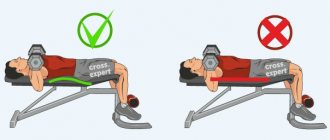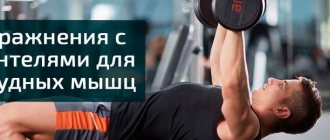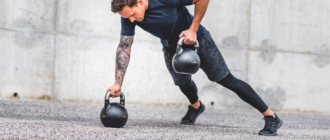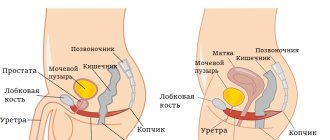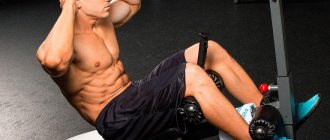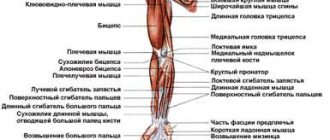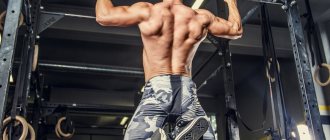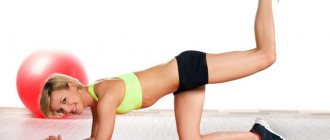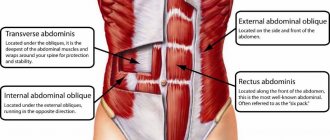Chest exercises with dumbbells are perfect for high-quality, comprehensive development of the muscles of the upper body. They are included in the training scheme by both beginners and experienced athletes. After all, a compact universal equipment does not take up much space; if you wish, you can practice at home.
There is an opinion that it is possible to achieve well-developed pectoral muscles only with the help of special stationary exercise machines or barbells. This statement is completely wrong. It is dumbbells that can provide sufficient freedom of movement, which allows you to intensively work out various muscle groups. In addition, with their help it is quite possible to correct asymmetry if one part of the breast is more developed. Of course, in order to achieve a good result, you need to know how to train correctly and what exercises should be included in your training regimen.
How to pump up your chest with dumbbells: basic rules
The pectoral muscles are divided into the major and minor muscles. But all exercises aimed at its development are usually divided according to their effect on the upper, middle and lower zones. Each group should be given sufficient attention during the training.
After intense exercise, muscles need to recover. Therefore, daily workouts until you break a sweat will not only not bring the expected results, but will also lead to serious injuries. Breaks between classes are required.
While performing the exercises, you should periodically change their order. So the muscles will not be able to quickly adapt to the given loads.
Also, it is important to remember that the lower and middle zones are much easier to work out. But the top one has to be loaded with special care. It is best to set aside a separate day for it. The ideal option: train the general pectoral muscle group twice a week and target the upper muscles once.
Leveling rules
Almost every guy wants to achieve large chest volume. To achieve success, a person should perform the exercises with proper technique. The easiest way to enlarge male breasts is to hire a personal trainer. However, if a person does not have such an opportunity, then he should learn from his mistakes and practice. Rules for pumping up male breasts:
- Start all exercises with a warm-up. If an athlete performs a bench press, the load falls on the shoulder joints. If you do not warm up, the bodybuilder runs the risk of injury.
- Conduct training maximum 2 times a week. A person should rest for more than 2 days.
- You need to select activities so that the upper chest is stressed the most. The lower part of the muscles should be devoted to 10-15 minutes of training.
- Increase the weight of projectiles. A person should select the weight based on his capabilities. If an athlete easily performs 15-20 repetitions, then he needs to increase the weight of his equipment.
- Muscle will not increase if a person does too many or few repetitions.
Professional bodybuilders recommend working the chest at the very beginning. For example, Arnold Schwarzenegger began each of his workouts by pumping his chest. Experienced athletes recommend performing 2 warm-up exercises. Then start increasing the weight and decreasing the number of repetitions. Between sets, bodybuilders recommend stretching your muscles. This will increase blood flow and maintain joint flexibility.
Principles to follow when working the pectoral muscles
Of course, everyone who is just starting to train wants to get results as quickly as possible. However, it is impossible to create a sculpted, beautiful body in a couple of weeks. To achieve what you want, you have to work hard and hard. But the main thing is a competent approach to drawing up a training program and following simple rules to increase the effectiveness of chest exercises with dumbbells.
- Don't ignore the need to take breaks between workouts, don't overload your body. The optimal rest for the pectoral muscles is 50-56 hours. If you exercise too often, the regeneration process will slow down. The muscles will develop more slowly or stop growing altogether.
- It is best to train according to a plan: one lesson every 3-4 days.
- In addition to physical activity, you need to switch to an appropriate diet. Proper nutrition will increase the effectiveness of your workouts.
- Equally important is the break between sets of exercises. Usually it is 4-5 minutes.
- All movements must be performed smoothly, without sudden jerks.
- Focusing all your attention on just one muscle group is a big mistake. It is necessary to load the arms and back in parallel with the pectoral muscles. Otherwise, the body will look disproportionate.
- During exercise, do not straighten your arms completely; keep your elbow joints slightly bent.
- Always grasp the implements with both hands and keep them level to distribute the weight evenly.
- To work the pectoral muscles, you should select fairly heavy dumbbells, since chest training should be intense.
- At the initial stage of training, use light weights. Take your time and let your muscles warm up. Otherwise, there is a high probability of injury and permanent failure.
- When practicing, concentrate not on the number of repetitions, but on the technique of performing movements. It's better to do less, but do it right.
- Don't try to do the same number of reps with a lot of weight. The heavier the dumbbells, the fewer repetitions.
- Choose collapsible models of equipment for training. With them it is convenient to control the burden, reducing it or increasing it if necessary.
- Before working out the pectoral muscles, you should perform exercises aimed at strengthening the deltoids and triceps.
Home workout
Training the pectoral muscles itself is very energy-intensive, so many people also use it to burn excess fat.
A person often comes up with a large number of different excuses for himself why he cannot train and go to the gym.
Usually everything is attributed to workload, frequent business trips, inconvenient location or embarrassment to work with someone nearby and be constantly in sight.
But this should not become a reason to deny yourself the pleasure of becoming the owner of a beautiful and athletic figure.
Therefore, most people prefer exercising at home. In this case, it is not the place that is important, but the perseverance and determination of the person.
Previously, we talked about how to pump up your breasts.
Warm-up for training with dumbbells for the chest
Before you begin performing a set of basic exercises with dumbbells for the pectoral muscles, you need to warm up thoroughly. Warm-up movements help the muscles warm up and prepare them for the upcoming load. When planning your workout, be sure to devote enough time to them. This will increase the effectiveness of your exercises and minimize the likelihood of injury.
Below are a few warm-up exercises that you should take note of when creating your training regimen.
Raising and crossing your arms in front of you
Stand up straight with your arms extended in front of you. Smoothly bring them together and spread them apart, feeling how the muscles stretch. Alternate limbs as you go. Alternately raise your right and left hand.
Make 8-10 breedings/crosses.
Elbow rotation
While in a standing position, spread your arms to the sides and bend them at the elbows. Shoulders should be parallel to the floor surface, hands pointing down (T-shaped pose). Now slowly rotate your forearms alternately inward and outward. Make sure your elbows remain in place perpendicular to your body.
Perform 6-8 rotations in each direction.
Arm flexion and extension
This warm-up movement is similar in technique to the dumbbell chest press, but is performed without implements.
Stand up straight, stretch your arms along your body. Now bend and straighten them, pulling your fists towards your shoulders, tensing your pectoral muscles, triceps and biceps as much as possible. When performing, the elbow joints should be pulled back, which will increase the load on the muscles.
To warm up, 8-10 repetitions are enough.
Rotation with brushes
Don't underestimate the significance of this simple movement. It is necessary for everyone who plans to train with a barbell or dumbbells. Can be performed standing or sitting.
Hold your hands in front of you (it is not necessary to extend them, just bend them slightly at the elbows). Now clench your fists and begin to rotate them smoothly, first in one direction, then in the other. At this moment, the wrist joints are warmed up, the palms are prepared for grip.
You need to make 8-10 rotational movements in each direction.
The warm-up should be completed by running in place at a moderate pace. It’s a good idea to add lateral raises to it for more load. This way you can fully prepare your muscles for the upcoming workout.
Dumbbell press.
One of the reasons why symmetry is so valued in bodybuilding is that humans, like the vast majority of other living beings, do not have symmetry. As a rule, we are right-handed or left-handed, we have one pushing leg, and so on. If, in an attempt to build a chest, we use only a barbell, then sooner or later we will inevitably encounter a situation where the dominant hand does all the work, and the lagging hand provides some assistance.
Therefore, the more actively you use unilateral (one-sided) exercises, the less effort you will need to put in to level your balance. But that's not all. Even if you press dumbbells, you may notice that the two sides of your body still seem to continue to try to distribute the amount of work between them.
Tip: Do this - leave one hand in the starting position, and perform the required number of repetitions in the set with the other, then change hands. In addition to core stabilization, which is also very important, you will notice that you can focus much better on all the nuances of the movement of each arm individually.
Exercises with dumbbells for the chest
Now it’s time to move on to the main training complex. Below we present the most effective exercises for the pectoral muscles, which are suitable for both men and women. The only difference is the weight of the shells used.
Dumbbell bench press
Sit on a bench, with your feet flat on the floor. The shoulder blades are brought together, the straightened arms are located above the chest area. In this case, the projectiles must be held with a direct grip. Bend your elbow joints slightly, which will avoid injury and do not transfer the load to the triceps muscle.
Now inhale and slowly lower your arms. So that the shells are at chest level. Exhaling, lift the dumbbells, returning to the starting position.
Raising your arms to the sides on a straight bench
Take a horizontal position with your feet on the floor. Raise your hands with the apparatus up above your chest. Make sure the weights lightly touch each other. Don't forget - the elbow joints should be slightly bent, the load should be held with a neutral grip.
Inhaling, slowly spread your limbs apart. At the lowest point, the shoulders should be slightly lower than the body. But there is no need to bring it to a state of severe discomfort in the muscles. Stay in this position for a few seconds. Next, emptying your lungs of air, return to the starting position.
Lifting weights on an inclined bench
Now we pump up the pectoral muscles with dumbbells, changing the position of the training bench. It is recommended to set the tilt angle to 30-45 degrees, which will minimize the work of the deltas.
Sit on a bench. Make sure that your lower back, back and back of your head are pressed tightly against its surface. Now move the projectiles to the chest area. Hold them as if they were a barbell.
As you exhale, smoothly raise your arms, but do not bring them together at the top point; the projectiles should not touch each other. Inhaling, return to the starting position.
Bench raises on a bench
To perform this exercise, you will again need to set the back of the training bench at an angle of 30-45 degrees.
After completing the adjustment, take a lying position. Place your feet on the floor, don’t forget to press your back, lower back and back of your head against the bench.
Hold the dumbbells and raise your arms up. The elbow joints should be slightly bent. Emptying your lungs of air, slowly spread your limbs to the sides. Make sure your shoulder blades remain retracted and your elbows point down. At the bottom point, you will feel the pectoral muscles stretching (but there should not be any pain). As you inhale, return to the starting position.
Incline Dumbbell Bench Press
This exercise is focused on working the lower chest area. It is important to remember that it is contraindicated for people with high blood and intracranial pressure. It should only be performed by athletes in good health and good physical shape.
To begin, set the bench to a negative incline angle of 30 degrees. Place yourself on its surface, securing your toes to special bolsters. Take dumbbells (in this case, it’s a good idea to use the help of a partner who will back up and supply the apparatus).
As you exhale, gently raise your arms up so that the weights lightly touch each other. As you inhale, lower your limbs down until the dumbbells touch your shoulders or chest area.
Breeding exercises on a bench with a downward inclination
Another chest exercise with dumbbells, which is strictly contraindicated for people with high blood pressure. Since, in this position, the load on the blood vessels of the brain significantly increases.
Sit on a bench with a negative incline angle set at 30 degrees. Hook the toes of your feet onto the bolsters. Now take the implements (or use the help of a partner) and raise your arms up, remembering to keep your elbows slightly bent.
As you inhale, gently spread your limbs to the sides. Take your time, feel the pectoral muscles stretch. Exhaling, return to the starting position. Avoid sudden jerks while performing.
Pullover
It can be performed both along and across the training bench. In the second case, only the upper back area touches the surface of the bench. This position promotes better muscle stretching.
Take the desired position (lengthwise or crosswise), take one dumbbell in your hands and lift it above your chest. Remember to keep your elbows slightly bent. Do not straighten your limbs completely to avoid injury.
Now slowly lower the dumbbell behind your head while taking a deep breath. Pause for a few seconds and exhale, return to the starting position.
The movement is carried out due to the rotation of the arms in the shoulder joints.
Push ups.
You may notice that bison, dinosaurs and other animals in the gym either do not do push-ups at all, or do so extremely rarely. Some people explain this by saying that holding the bar takes up energy that could be spent on the chest; others still have a strong association with school physical education, when they were probably small and weak and the physical educator laughed at them.
Perhaps it's time to take a confident bench position, make your body a solid pressing unit, and not just a collection of disparate muscles, and finally show the ghost of an athlete what you have achieved. But for a reason! Take an elastic band, pass it behind your back and do push-ups so that the final phase is the hardest. In fact, such push-ups are an analogue of the technique when chains are attached to the bar, and at the bottom the weight is much less than at the top, since the chain then lies almost entirely on the floor. This exercise will perfectly pump up your boost and at the same time teach the body to use oxygen rationally, since even holding a bar with an elastic band will become harder.
Dumbbell chest exercises: training plan
The best option for training the pectoral muscles is one workout per week. As a rule, it is combined with working out the triceps, which is no less actively involved in performing various pressing movements.
A typical training scheme might look like this:
| Name of exercises | Number of approaches | Number of repetitions |
| Dumbbell bench press | 4 | 10-12 |
| Lifting shells on an inclined bench | 4 | 10-12 |
| Bench raises on a bench | 3 | 12-15 |
| Pullover | 3 | 10-12 |
| French bench press | 4 | 10-12 |
| Dave Tate Press | 3 | 10-12 |
Experienced athletes, if necessary, conduct classes twice a week.
The first workout looks something like this:
| Name of exercises | Number of approaches | Number of repetitions |
| Incline bench press | 5 | 8-10 |
| Bench raises on a bench | 4 | 10-12 |
| Pullover | 4 | 10-12 |
In the second, the emphasis is placed on the middle and lower thoracic region:
| Name of exercises | Number of approaches | Number of repetitions |
| Bench press on a straight bench | 4 | 8-10 |
| Incline Dumbbell Bench Press | 4 | 10-12 |
| Raising your arms to the sides on a straight bench | 3 | 10-12 |
The above training schemes can be supplemented with other exercises for the arms and chest, choosing the most effective program for yourself. It is quite possible to pump up your pectoral muscles with dumbbells. The main thing is to take a responsible approach to the process of forming a sculptural body. Don’t skip workouts, eat right, and don’t stop at the results achieved. In other words, work hard and hard. But the reward for the efforts spent will be sculpted pectoral muscles, which many can only dream of.
Sample program
To pump up your breasts at home, you need to create a clear training plan. We offer an example of such a plan.
- Jumping rope for general warming up of the body (3-5 minutes), warming up the shoulder, elbow, and wrist joints.
- Bench press (3-4/8-12).
- Lying dumbbell flyes (3-4/12-15).
- Dips (3-4/8-12).
- Pullover (3-4/12-15).
- Chair push-ups (3-4/12-15).
If you don't have barbell racks at home, replace the bench press with weighted push-ups (with a heavy backpack on your back). At the end of the session, stretch your pectoral muscles. This will help them recover faster.
Read more about post-workout stretching →
Read also
- How to pump up your biceps - exercises for strong biceps
- Training with dumbbells for all muscle groups
- We train the whole body with kettlebells. A set of exercises that can be added to regular exercise
- Chest exercises – a set of exercises for the chest muscles, top most effective + training program
- How to pump up your arms at home - training your arms at home
- Triceps exercises with dumbbells
- A set of exercises with dumbbells - what exercises to do if you only have free weights at hand
Breast structure
The rib cage consists of two main muscles; pectoralis major and pectoralis minor. They are both found under the breast tissue and on top of the breast bone. These muscles also connect to the humerus. The main job of the chest muscles is to allow you to move your arms and shoulders in different ways.
Women have extra muscles in their chests called Cooper's ligaments. These are thin plexuses of connective tissue that work together to keep the breasts upright. With age, these ligaments become weaker and weaker. As a result, the chest begins to droop.
The targeted exercise will tighten Cooper's ligaments in the same way a sailor might tie a sailor's knot. This will lift your bust and slightly increase its volume and firmness.
It's easy to neglect chest training in favor of areas where fat accumulates faster in a woman's body: the thighs, buttocks, and abdomen. However, this is a mistake. Regular chest exercises will quickly transform your bust, making it more seductive and pert. At the same time, your posture will improve. Your entire upper body will also become stronger. As an additional bonus, your shoulders will become more prominent and acquire a characteristic curve, and this is a trait of a woman who takes care of herself. We have selected the 13 best exercises for beautiful and firm female breasts and grouped them by degree of difficulty.
